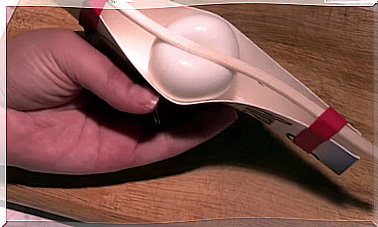Heart Rate: What Is It And How Is It Measured?
Heart rate is defined as the number of heart contractions or beats per unit of time. This parameter is measured under well-determined physiological conditions and is expressed in beats per minute (beats / min).
The speed of the heartbeat depends on many factors, such as physical activity, threats to safety, and individual emotional responses. As you can imagine, the heart rate is very different at the time of a traffic accident or in bed resting. If you want to know everything about this vital parameter, keep reading.
What is heart rate?
As indicated by the Spanish Heart Foundation, the heart rate represents the number of times the heart contracts per minute. This tireless organ pumps 70 milliliters of blood with each heartbeat, or what is the same, about 5 liters in 60 seconds. To do this, your muscles must contract and relax rhythmically.
On a physical level, it is a cyclical event, since it is repeated in a specific unit of time with total periodicity. Although a normal heart rate does not ensure that the individual is disease free, it is a useful parameter for identifying a wide variety of disorders.
According to the World Health Organization (WHO), ischemic heart disease is the leading cause of death in the world in high-income countries, well above cancers and other types of pathologies. It accounts for 47% of all deaths and in Europe it causes 4 million deaths annually. Without a doubt, paying attention to the heart can save lives.

How is heart rate measured?
The United States National Library of Medicine shows us the most effective ways to measure heart rate. In general, the pulse can be measured in areas where the arteries pass close to the skin.
Some viable sites for this are the wrist, top of the foot, temple, neck, and groin. The most common way at home is by taking the pulse at the wrist.
To do this, you must perform the following steps:
- Gently press the inside of the wrist on the side of the thumb. You will notice under your skin the radial artery, which runs through the radial canal.
- Place your index and middle fingers 1 to 2 centimeters below the crease of the wrist, between the bone that is palpable outward and the tendon on the inner side.
- As soon as you feel the first beat, start counting the number that occurs in 60 seconds with the help of a stopwatch. You can also count the beats in 30 seconds and then multiply them by 2, although this mode is not without more errors.
If you don’t want to do it manually, don’t worry. Many devices that measure blood pressure (such as the wrist monitor) also indicate the patient’s heart rate on their digital display. Using these gadgets is straightforward and it doesn’t take more than a couple of minutes to get the results.
What is the normal heart rate?
Perhaps knowing the answer to this question is why you are here. The individual heart rate depends on many factors, but we show you the normal results in 2 very specific situations: rest and exercise.
Idle frequency
According to the American Heart Association, your resting heart rate is the one that pumps the least amount of blood needed, since you are not exercising. If the patient is lying down and relaxed at home, the average rate will be between 60 and 100 beats per minute (beats / min).
However, a rate less than 60 beats / min is not always a sign of disease. For example, patients taking beta-blocker drugs have lower frequencies. They are prescribed, above all, in heart rhythm disorders and to protect the heart after a heart attack.
On the other hand, a person who exercises very assiduously may also have a heart rate below 60. This is because the heart muscle is in good shape and therefore does not need to work as hard to maintain a stable heartbeat. .
The normal resting rate varies greatly depending on the age of the patient. We present a list with the expected values according to the group:
- Newborns from 0 to 1 month of age: 70-190 beats / min.
- Babies 1 to 11 months of age: 80-160 beats / min.
- Children 1 to 2 years of age: 80-130 beats / min.
- Infants 3 to 4 years of age: 80-120 beats / min.
- Children 5 to 6 years of age: 75-115 beats / min.
- Children 7 to 9 years of age: 70-110 beats / min.
- Adults: 60-100 beats / min.
- Well-trained adults or those who are professionally engaged in sports: 40-60 beats / min.
The heart rate in children is higher because their heart has not yet fully developed. Myocytes (heart cells) are smaller and unorganized. Therefore, the shrinkage capacity is lower. To pump the necessary amount of blood, it must beat more times.
Frequency during exercise
During times of physical activity the heart should beat faster. Muscles require more nutrients and oxygen, since they are expending energy, so more blood has to reach them in the same unit of time.
Therefore, it is considered normal that the heart rate when exercising is 150-200 beats per minute.
What factors can alter the heart rate?
There are many factors that alter your heart rate, beyond exercise and rest. Sources already cited show us some of the parameters that can cause the heart rate of a healthy person to present values outside the normal range.
1. Air temperature
Generally speaking, at an ambient temperature between 16 and 24 degrees the heart rate can be increased normally between 2 and 4 beats per minute. If the temperature is around 25-30 degrees, the frequency can be increased by up to 10 beats per minute.
2. Position
Whether the person is sitting or standing (resting), the heart rate is usually the same. However, if you take your pulse right after sitting up, it may be a little higher than normal. Therefore, it is recommended to wait a couple of minutes after getting up to measure this parameter.
3. Emotions
Anxiety, stress, and other emotions can increase the number of heartbeats. We speak of a tachycardia when the pulse increases to 130-140 beats per minute. Psychological help and learning relaxation techniques are usually the best tools to deal with these types of events.
4. Weight
Weight does not affect heart rate. However, if the patient has a very high body mass index, the resting pulse may be higher than normal. After all, in obese people the heart must make more force so that the blood reaches the entire mass.

5. Medications
As we have said, beta-blockers are designed to slow the heart rate in patients with a fragile heart. On the other hand, the consumption of thyroid drugs increases the frequency of the heartbeat.
Check if your heart rate is not adequate
As you may have seen, heart rate is a vitally important parameter that provides a lot of information about the immediate health status of the patient. In any case, an adequate number of beats per minute does not imply being free of all pathology.
In any case, we recommend that you go to the doctor if in several batches you collect a heart rate much lower or higher than normal. Although it may be a physiological characteristic, it is always better to be safe than sorry.








